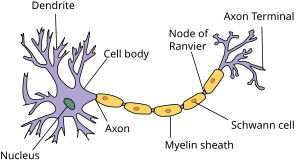Neuron
A neuron[1] (or neurone) is a nerve cell that carries electrical impulses.[2] Neurons are the basic units of our nervous system.

Neurons have a cell body (soma or cyton), dendrites and an axon.[2] Dendrites and axons are nerve fibers. There are about 86 billion neurons in the human brain. Almost all brain cells are neurons. The human brain has about 16 billion neurons in the cerebral cortex. The neurons are supported by glial cells and astrocytes.[1]
Neurons are connected to one another, but they do not actually touch each other. Instead they have tiny gaps called synapses. These gaps are chemical synapses or electrical synapses which pass the signal from one neuron to the next.
Types of neurons
changeBy connection
changeThere are three classes of neurons: motor neurons, sensory neurons and inter neurons.
- Sensory neurons carry information from tissues and organs into the central nervous system.
- Motor neurons transport signals from the central nervous system to the effector cells.
- Interneurons connect neurons within the central nervous system.
By function
change- Sensory neurons carry signals from sense organs to the spinal cord and brain.
- Relay neurons carry messages between sensory or motor neurons and the central nervous system
- Motor neurons carry signals from the CNS to muscles, motor neurons are connected to the relay neurons. The signal passes between the neurons via synapses. Synapses are microscopic voids between cells where chemicals are released from the axon terminal of one cell to specialized chemical receptors on the dendrite of the receiving cell.
Cell division
changeMature neurons never divide: that is the general rule. They do not undergo cell division. In most cases, neurons are generated by special types of stem cells. A type of glial cell, called astrocytes, have also been seen to turn into neurons. In humans, neurogenesis (the origin of new nerve cells) largely ceases during adulthood – but in two brain areas, the hippocampus and the olfactory bulb, there is strong evidence for substantial numbers of new neurons.[3][4].[4][5][6]
Related pages
changeReferences
change- ↑ 1.0 1.1 "Neurons: What are they and how do they work?". www.medicalnewstoday.com. 2017-12-07. Retrieved 2021-11-07.
- ↑ 2.0 2.1 Fullick, Ann (2011). Edexcel ICSE Biological Revisions Guide1. Pearson Education Limited. p. 40. ISBN 9780435046767.
- ↑ Wade, Nicholas (1999-10-15). "Brain may grown new cells daily". The New York Times.
- ↑ 4.0 4.1 Nowakowski, R.S. (2006). "Stable neuron numbers from cradle to grave". Proceedings of the National Academy of Science. 103 (33): 12219–12220. Bibcode:2006PNAS..10312219N. doi:10.1073/pnas.0605605103. ISSN 0027-8424. PMC 1567859. PMID 16894140.
- ↑ Blinkov S.M. & Glezer I.I. 1968. The human brain in figures and tables: a quantitative handbook. New York, Plenum.
- ↑ Roth, Gerhard 2013. The long evolution of brains and minds. Springer, Dordrecht.
Other websites
change- Fibrinogen found to inhibit EGFR in neuronal cells Archived 2021-04-13 at the Wayback Machine Blood clotting protein may inhibit spinal cord regeneration
- Cell Centered Database Archived 2007-08-13 at the Wayback Machine UC San Diego images of neurons.
- High resolution neuroanatomical images of primate and non-primate brains Archived 2019-06-21 at the Wayback Machine.